
11. James Knox Polk

Democrat,
1795-1849, President 1845-1849
Nickname: Young Hickory VP: George Dallas,
Wife:
Sarah Childress
Though he instituted "Hail to the Chief" as the accompaniment
to a presidential entrance and hosted the first Thanksgiving dinner at the White
House, Polk gave some of its most boring parties. No music, alcohol, or dancing allowed;
Polk himself was humorless and suspicious. His wife, Sarah, who was extremely religious,
was his private secretary and his chief consultant. They had no children, worked
hard and slept little. Polk virtually worked himself to death, dying at age 53, three
months after leaving the White House---the shortest retirement of any president.
Not trusting banks, he'd keep his money in bags around the house. He left everything
to Sarah, with the provision that their slaves be freed at her death. She lived for
42 more years, never home again except to go to church.
Hail
to the Chief
12. Zachary Taylor
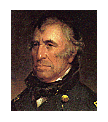
Whig,
1784-1850, President 1849-1850
Nickname: Old Rough and Ready VP: Millard Fillmore,
Wife:
Margaret Smith
He chewed tobacco.
He was the first president who had never
held any previous political office.
He wore odd combinations of cilvian and military
dress.
He was a terrible speller.
He had 6 children.
He died at age 65,
after 16 months in office, he suffered a digestive upset from pickled cucumbers,
cherries and an iced milk. He died five days later. Many people thought he was poisoned
with Arsonic but historians discovered this was false in 1991.
He'd oppose slavery
The
Exhumation of President Taylor
13. Millard
Fillmore
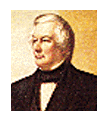
Whig,
1800-1874, President 1850-1853
Nickname: The American Louis Phillipe, VP: None,
Wife:
Abigail Powers, s: Caroline
He was the first President to have a stepmother.
He
married his first wife who had been his school teacher. She was the first First Lady
to have held a job outside of the home.
She established a library for first families
in the White House.
He is remembered for the Compromise of 1850 which admitted
California into the union .
Biography
14.
Franklin Pierce
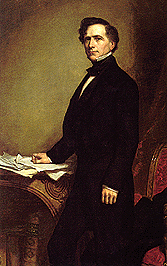
Democrat,
1804-1869 President 1853-1857
Nickname: Young Hickory of the Granite Hills,VP:
William King,
First Lady: Jane Appleton
He was the most handsome President
but was often depressed and suffered from alcoholism. All 3 of his sons died, one
of them right before their eyes falling out of a railroad car.
He installed central
heating and a second bathroom in the White House as well as the first Christmas Tree.
He supported the south in the Civil War and was disliked by his neighbors after
he retired because of it. He died at age 64.
The
Pierce Manse
15. James Buchanan
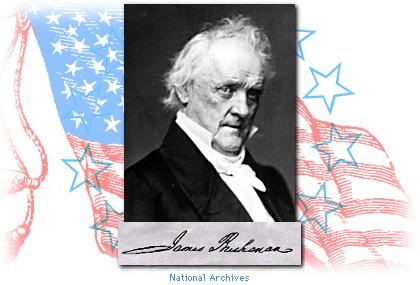
Democrat
1791-1868 President: 1857-1861
nickname: Old Buck, VP: John Breckenridge,
First
Lady: None, First bachelor
Since he was a bachelor, his niece Harriet Lane was
his hostess.
He was given many pets for company including a herd of elephants,
a pair of bald eagles, and a newfoundland dog.
He cocked his head a lot due to
being farsighted in one eye and nearsighted in the other. He would buy slaves in
order to free them.
Wheatland, Buchanan's
home
16. Abraham Lincoln

Republican,
1809-1865, President: 1861-1865
Nickname: Honest Abe, VP: Hannibal Hamlin, Andrew
Johnson,
First Lady: Mary Todd
He was the tallest President(6"4)
He
was moody at times, but loved to tell jokes and stories. He was not very organized
and only had one year of formal education. He allowed his sons to have all the pets
the wanted at the White House including two pet goats Nanko and nany, a cat named
Bob and a turkey named Jack.
He recieved thousands of death threats and once stated
"I
cannot bring myself to believe that any human being lives who would do me any harm"
He
was shot by John Wilkes Booth in fords theatre while watching "Our American
Cousin" and died 9 days later at age 56. The first President to ever be assinated.
Lincoln's
Photos, Words and Timeline
17. Andrew
Johnson
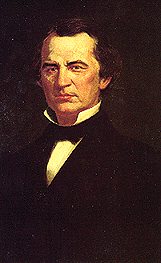
1808-1875,
President: 1865-1869
Nickname: "The Grim Presence" VP: None,
First
Lady: Eliza McCardle
He was the first president to hever attend school. He was
a tailor by trade, and was taught to read by his wife who was teh First Lady to marry
at age 16.
His daughter Martha was often the hostess at the White House as his
wife had tuburculosis.
He ws the first to be impeached but not removed from office.
Though later he went on to be a senator and died 5 months into his term at age 67
of a stroke.
Andrew Johnson National Historic Site
18.
Ulysses Simson Grant

1822-1885,
President 1869-1877
Nickname: Hero of Appomattox, VP : Schuyler Colfax, Henry
Wilson,
First Lady: Julia Dent
He was a general and a graduate of West Point.
He was at first rejected from the military for his reputation as a heavy drinker.
He
was the first President to have a women run against him during a campaign. He loved
to eat cucumbers soaked in vinegar for breakfast. He smoked up to 20 cigars a day.
He
was tone deaf, and was a man of few words. He once stood up and said " I rise
only to say I do not intend to say anything."
He once had to pay a 20 dollar
fine for speeding with his horse through town.
He died of throat cancer and finished
a book 3 days before he died at age 63 which left his wife financial stable from
the profits.
Ulysses S Grant Network
Home Page
19. Rutherford Birchard
Hayes
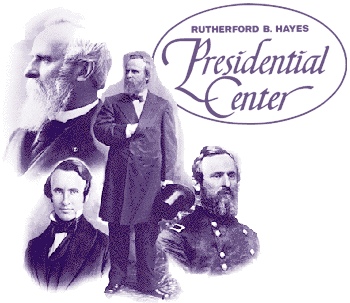
1822-1893,
President 1877-1881
Nickname: Dark-Horse President, VP: William Wheeler,
First
Lady: Lucy Webb
Rutherford Birchard Hayes was born in Delaware, Ohio, on Oct.
4, 1822. A graduate of Kenyon College and the Harvard Law School, he practiced law
in Lower Sandusky (now Fremont) and then in Cincinnati. In 1852 he married Lucy Webb.
A Whig, he joined the Republican party in 1855. During the Civil War he rose to major
general. He served in the House of Representatives from 1865 to 1867 and then confirmed
a reputation for honesty and efficiency in two terms as Governor of Ohio (1868–72).
His election to a third term in 1875 made him the logical candidate for those Republicans
who wished to stop James G. Blaine in 1876, and he was nominated.
The result
of the election was in doubt for some time and hinged upon disputed returns from
South Carolina, Louisiana, Florida, and Oregon. Samuel J. Tilden, the Democrat, had
the larger popular vote but was adjudged by the strictly partisan decisions of the
Electoral Commission to have one fewer electoral vote, 185 to 184. The national acceptance
of this result was due in part to the general understanding that Hayes would pursue
a conciliatory policy toward the South. He withdrew the troops from the South, took
a conservative position on financial and labor issues, and urged civil service reform.
Hayes
served only one term by his own wish and spent the rest of his life in various humanitarian
endeavors. He died in Fremont on Jan. 17, 1893
Rutherford
B. Hayes
Inaugural
Address
20. James
Abram Garfield
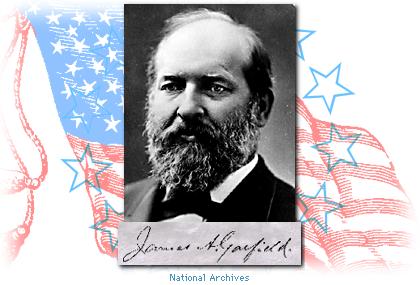
1831-1881,
President 1881-1881
Nickname: None VP: Chester Aurthur
First Lady: Lucretia
Rudolph
Four months after taking office he was wounded fatally by an assassin's
bullet. His administration is remembered for a struggle over patronage, exposure
of the Star Route frauds, and the beginnings of a friendlier policy toward Latin
America. Had Garfield never been president his distinguished service in the HOUSE
OF REPRESENTATIVES would have earned him a place in American history. James Abram
Garfield was born in a log cabin near Cleveland, Ohio, on Nov. 19, 1831, the youngest
of five children of Abram and Eliza Ballou Garfield. Raised by his mother, who was
widowed in 1833, James grew up in poverty. Though bright and anxious to learn, he
turned 17 with but little schooling. In 1848 he struck out on his own and worked
on a canal boat, but about six weeks later he returned home seriously ill. While
convalescing he decided to get an education.
For the next decade religion
and academic life occupied Garfield. He attended a seminary, taught in district schools,
and from 1851 to 1854 studied and taught at the Western Reserve Eclectic Institute,
now Hiram College. Through these years Garfield was an introspective person with
narrow views and a small circle of friends. Deeply religious, he zealously embraced
and preached the doctrines of the Disciples of Christ. From the Eclectic, a Disciple
school, he entered Williams College. He graduated with honors in 1856.
Garfield
returned to Hiram, became principal of the Eclectic in 1858, and instilled new life
into the school. He preached, officiated at marriages and funerals, and lectured.
During these years Garfield turned against slavery and became interested in politics.
In 1859 he was elected as a Republican to the Ohio Senate, where he denounced slavery
and secession, advocating force, if needed, to preserve the Union. He studied law
and was admitted to the bar. In 1858 he married Lucretia Rudolph, a former classmate.
In the Civil War Garfield rose from lieutenant colonel to major general. He provided
superb military leadership, demonstrating a sound understanding of tactics, strategy,
and the relationship between war and politics. From the outset he favored emancipation
of the slaves and conquest of the South.
His initial battlefield assignment
was at the head of a brigade that drove invading Confederates from eastern Kentucky.
He led another brigade in the Shiloh and Corinth campaigns, after which he returned
home on sick leave.
In 1863, Garfield became chief of staff to General William
S. Rosecrans, commander of the Army of the Cumberland, and served through the Tullahoma
and Chickamauga campaigns. After the Battle of Chickamauga, in which he performed
heroically, Garfield resigned his commission to enter the U.S. House of Representatives,
to which he had been elected in 1862.
Garfield served in the House from 1863 to
1880. He was broadly intelligent, national in outlook, and generally moderate in
his views. He tempered idealism with practicality. He worked hard and spoke and wrote
well. From 1871 to 1875 he was chairman of the committee on appropriations.
During
Reconstruction, Garfield sided with the Radical Republicans in supporting black suffrage,
congressional Reconstruction, and the impeachment of President Andrew JOHNSON. But
events gradually convinced him that progress in the South would come only with education,
business enterprise, and time.
An articulate defender of a conservative monetary
policy, Garfield urged the resumption of specie payments and the payment of government
debts in coin. Although he opposed the coinage of overvalued silver, he became interested
in the possibility of a sound bimetallic standard.
Garfield was a moderate
protectionist, looking to the time when American industry would be competitive without
tariff supports. His record enabled his party to make protection for home industry
a leading issue in 1880.
Garfield believed that in education lay the great
hope of a democracy. He was the House leader in establishing the U.S. Department
(later Bureau) of Education. He supported the education of deaf persons, served as
a regent of the Smithsonian Institution, and helped to create the U.S. Geological
Survey.
On three occasions Garfield was widely criticized for actions that
seemed to reflect on his integrity as a public man. These incidents, the most famous
of which was the Crédit Mobilier scandal, should not obscure a notable congressional
career. Today it appears that his weaknesses were largely of judgment rather than
character.
Garfield helped elect Rutherford B. HAYES president, serving on
the electoral commission formed to settle the disputed election of 1876. During the
Hayes administration he was minority leader of the House. In January 1880 he was
elected to the U.S. SENATE.
But Garfield never had a chance to take his Senate
seat. In May 1880 he was a delegate to the REPUBLICAN National Convention. A well-known
party leader for whom a presidential movement was already afoot, he attracted much
favorable attention. Garfield placed John Sherman's name in nomination for president.
After 34 ballots had failed to nominate Ulysses S. GRANT, James G. Blaine, or Sherman,
the supporters of Blaine and Sherman united on Garfield, who won on the 36th ballot.
Garfield's
humble origin, his political record, his conduct as a candidate, a vigorous Republican
campaign, and the political inexperience of his rival brought a narrow victory. The
new president was a large man, six feet tall and weighing 210 pounds. He had light
brown hair and a beard flecked with gray. His months in the White House, though few,
were busy and dramatic. Office seekers descended in droves. A struggle over New York
political appointments developed between the President and Senator Roscoe Conkling,
New York's Republican chieftain, and Garfield's victory in it enhanced his prestige
and strengthened the presidential power. Exposure of the Star Route frauds, involving
mail contracts in the West, created a sensation. Under Garfield's direction Secretary
of State James G. Blaine began to lay foundations for improved relations with Latin
America. Developments seemed to foreshadow a vigorous and able administration.
On
July 2, 1881, Garfield was shot in a Washington railroad station. The assassin, Charles
J. Guiteau, was a mentally unbalanced man who had unsuccessfully sought a federal
appointment.
The President died at Elberon, N.J., on September 19. Seldom
had Americans felt such public grief and indignation. The grief momentarily made
Garfield appear greater than he was. The indignation hastened civil service reform,
which Garfield himself had for some time advocated.
Alexander
Bell and the Garfield Assination
1-10
21-30 31-40 41-43










